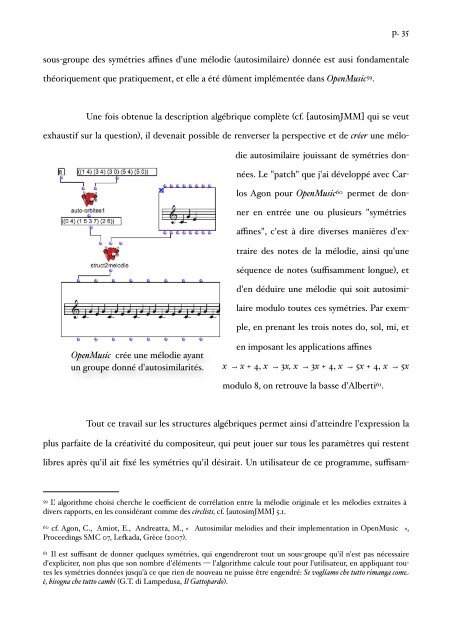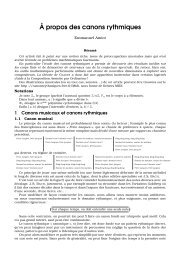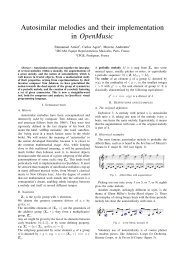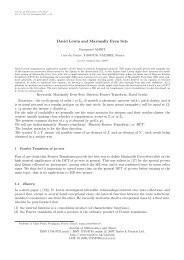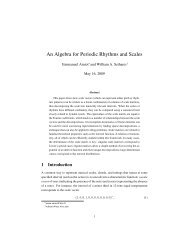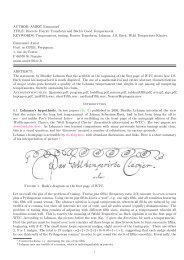Emmanuel Amiot Modèles algébriques et algorithmes pour la ...
Emmanuel Amiot Modèles algébriques et algorithmes pour la ...
Emmanuel Amiot Modèles algébriques et algorithmes pour la ...
Create successful ePaper yourself
Turn your PDF publications into a flip-book with our unique Google optimized e-Paper software.
sous-groupe des symétries affines d'une mélodie (autosimi<strong>la</strong>ire) donnée est ausi fondamentale<br />
théoriquement que pratiquement, <strong>et</strong> elle a été dûment implémentée dans OpenMusic 59.<br />
Une fois obtenue <strong>la</strong> description algébrique complète (cf. [autosimJMM] qui se veut<br />
exhaustif sur <strong>la</strong> question), il devenait possible de renverser <strong>la</strong> perspective <strong>et</strong> de créer une mélo-<br />
die autosimi<strong>la</strong>ire jouissant de symétries don-<br />
nées. Le "patch" que j'ai développé avec Car-<br />
los Agon <strong>pour</strong> OpenMusic 60 perm<strong>et</strong> de don-<br />
Fig. 9. A palindrome with period 14<br />
ner en entrée une ou plusieurs "symétries<br />
affines", c'est à dire diverses manières d'ex-<br />
traire des notes de <strong>la</strong> mélodie, ainsi qu'une<br />
séquence de notes (suffisamment longue), <strong>et</strong><br />
d'en déduire une mélodie qui soit autosimi-<br />
<strong>la</strong>ire modulo toutes ces symétries. Par exem-<br />
Fig. 10. Autosimi<strong>la</strong>r melody with period 15 and its palindromic<br />
deformation<br />
ple, en prenant les trois notes do, sol, mi, <strong>et</strong><br />
en imposant les applications affines<br />
x → x + 4, x → 3x, x → 3x + 4, x → 5x + 4, x → 5x<br />
modulo 8, on r<strong>et</strong>rouve <strong>la</strong> basse d'Alberti61. sequences<br />
OpenMusic crée une mélodie ayant<br />
Fig. 8. This patch shows how to produce an autosimi<strong>la</strong>r melody (the<br />
Alberti Bass) un groupe starting with donné a s<strong>et</strong> of symm<strong>et</strong>ries, d'autosimi<strong>la</strong>rités.<br />
a period and a collection<br />
of pitches.<br />
2) Find a melody with some given symm<strong>et</strong>ries. One<br />
builds the orbits first as exp<strong>la</strong>ined below, from there it<br />
is the composer’s choice to associate notes to each orbit<br />
with a standard Tout OpenMusic ce travail procedure. sur les structures <strong>algébriques</strong> perm<strong>et</strong> ainsi d'atteindre l'expression <strong>la</strong><br />
The user inputs a collection of affine maps. Starting from<br />
plus an parfaite element xde in <strong>la</strong> Zn, créativité a s<strong>et</strong> is initialized du compositeur, with x as sole qui peut jouer sur tous les paramètres qui restent<br />
element. Then all the maps in the collection are applied<br />
libres repeatedly après toqu'il that ait s<strong>et</strong> fixé untilles it no symétries longer changes. qu'il désirait. All Un utilisateur de ce programme, suffisamelements<br />
of this s<strong>et</strong>, now an orbit, are s<strong>et</strong> aside and<br />
the algorithm carries on with the next element in Zn<br />
that has not been reached y<strong>et</strong>, until Zn is exhausted<br />
(see Fig. 8). This is the dual approach from the <strong>la</strong>st<br />
one, providing the composer with the simplest structure<br />
admitting autosimi<strong>la</strong>r copies with the desired ratios and<br />
offs<strong>et</strong>s.<br />
D. Palindromes<br />
The above concept enables to c<strong>la</strong>rify which autosimi<strong>la</strong>r<br />
melodies will be palindromes, as it is only a question<br />
of wh<strong>et</strong>her x ↦→ −x (or some more general inversion<br />
x ↦→ c − x) is present in the stabilizer of the melody.<br />
The algorithms allow the straighforward construction of<br />
palindromic melodies (among other symm<strong>et</strong>ries), and the<br />
theory reaches interesting result, as (simplifying a little)<br />
Theorem 6: An autosimi<strong>la</strong>r melody with ratio a will<br />
be palindromic iff there is some power of a equal to -1<br />
1 under reference A126949.<br />
Besides of course, it is always possible to build a palindromic<br />
(autosimi<strong>la</strong>r) melody from any autosimi<strong>la</strong>r melody<br />
by just col<strong>la</strong>psing tog<strong>et</strong>her notes belonging to orbits that<br />
are symm<strong>et</strong>rical (the map f : x ↦→ −x exchanges orbits of<br />
a primitive autosimi<strong>la</strong>r melody with ratio a). For example<br />
see the original and the ‘palindromized’ on Fig. 10<br />
obtained by col<strong>la</strong>psing tog<strong>et</strong>her the two inversionallyre<strong>la</strong>ted<br />
orbits (1, 2, 4, 8) and (7, 11, 13, 14). 2<br />
A nice theor<strong>et</strong>ical property of autosimi<strong>la</strong>r melodies<br />
appears when one tries to iterate an affine map with<br />
a ratio that is not invertible modulo n: the map being<br />
no longer one-to-one, there is no reversibility and some<br />
information is lost at each iteration, but (this is re<strong>la</strong>ted<br />
to the very deep Fitting Lemma of commutative algebra<br />
that already appeared in a musical context in Anatol<br />
Vieru’s sequences, [3]) after a time an autosimi<strong>la</strong>r melody<br />
59 L' algorithme choisi cherche le coefficient de corré<strong>la</strong>tion entre emerges <strong>la</strong> mélodie (see Fig. originale 11). <strong>et</strong> les mélodies extraites à<br />
divers rapports, en les considérant comme des circlists, cf. [autosimJMM] Thus chaos 5.1. hides inside itself the deepest harmony.<br />
60 cf. Agon, C., <strong>Amiot</strong>, E., Andreatta, M., « Autosimi<strong>la</strong>r melodies and their implementation in OpenMusic »,<br />
Proceedings SMC 07, Le1ada, Grèce (2007).<br />
61 Il est suffisant de donner quelques symétries, qui engendreront tout un sous-groupe qu'il n'est pas nécessaire<br />
d'expliciter, non plus que son nombre d'éléments — l'algorithme calcule tout <strong>pour</strong> l'utilisateur, en appliquant toutes<br />
les symétries données jusqu'à ce que rien de nouveau ne puisse être engendré: Se vogliamo che tutto rimanga come<br />
è, bisogna che tutto cambi (G.T. di Lampedusa, Il Gattopardo).<br />
Fig. 11. An autosimi<strong>la</strong>r melody from a random one<br />
IV. CONCLUSION<br />
We presented some theor<strong>et</strong>ical and implementational<br />
aspects of melodic autosimi<strong>la</strong>rity. After describing a gen-<br />
p. 35


